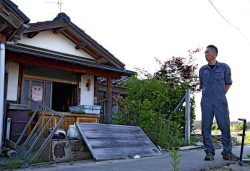8 Months After Noto Quake, 700 Households Still Without Running Water; Plan in Works to Restore Flow

A Self-Defense Forces member works at a temporary bathing facility in Suzu, Ishikawa Prefecture, on Saturday.
20:00 JST, September 1, 2024
SUZU, Ishikawa — Sunday marked eight months since the Noto Peninsula Earthquake, but many residents in severely affected areas of Ishikawa Prefecture still suffer from prolonged water outage.
The Jan. 1 earthquake caused water outages in about 110,000 households in the prefecture. Of them, 731 households in the cities of Suzu and Wajima are still left without running water.
The Suzu city government has been working to restore the water supply as soon as possible by proceeding with plans to install water pipes from Wajima to some parts of the city, but some residents will likely be facing life without running water for some time.
“I thought the water supply would be restored in April at the latest,” said Hideko Yoshida, 74, of the city’s Shimizumachi district. “I understand it’s not anyone’s fault, though.”

Hideko Yoshida uses rainwater to grow vegetables in her garden in Suzu, Ishikawa Prefecture, on Wednesday.
After returning from an evacuation center in late February, Yoshida and her husband, Koichi, 76, have been living in their home, which was certified as partially destroyed.
They carry 60 liters of water from a water station at an evacuation center 10 minutes away by car and have been doing that for half a year.
Yoshida said they have been careful about saving water. They take only showers and have not had a chance to take a bath since they returned to the house. To reduce the number of dishes to wash, they serve their food on a single plate as much as possible, and laundry is only done for dirty clothes. They use rainwater to grow vegetables in the garden, which they do as a hobby, but it seems the plants are not growing as well as usual, likely because of insufficient water.
“I’ve gotten used to this lifestyle, but I find it quite tough physically,” said Yoshida. “I want to go back to normal as soon as possible.”
However, the nearby Shimizu water purification plant, which supplies water to their district, was damaged by a landslide with no prospect for restoration.
Itsuro Minami, 85, has also lived without running water since returning to his home in the city’s Mauramachi district from an evacuation center in early March. As the road connecting the district to the city center remains cut off, he has to travel to the neighboring city of Wajima to get water. At home, he uses a portable toilet that does not require water.
Running water was cut off at about 4,800 households in Suzu at one point, but it has since been restored to about 90% of them, allowing many residents to gradually return to their daily lives.
“My life is so inconvenient that I can’t believe I live in the same city,” said Minami.
A plan is underway to connect a distribution pipe from the neighboring city of Wajima to bring water to the district.
After the Suzu city government approached the Wajima city government about the plan, the Wajima city assembly passed a proposal on Aug. 6 to build a 1.8-kilometer water pipe to a distribution reservoir in the district.
About 50 residents used to live in the district before the earthquake, but now there are only seven.
“The plan will also provide an opportunity for local people to return to the district,” said Minami.
According to the Suzu city government, 419 households remained without running water as of Aug. 20. The local government plans to use portable water purification equipment to secure water in all areas except for Mauramachi district and aims to start operation by the end of September.
In Wajima, 312 households are still left without running water, and they are all located in areas where it is difficult to restore service. There are also some houses without water supply due to unfinished repairs to water pipes on the premises.
End of SDF mission
The Self-Defense Forces’ relief activities in the disaster-stricken areas ended Saturday.
As their last mission, they set up temporary bathing facilities inside three makeshift tents in Suzu for local residents to relax.
Katsunori Heizei, 70, still has no running water in his house in the city’s Takojimamachi district. “I just realized how grateful I was to be able to take a bath,” he said, adding that he thanked SDF personnel for their assistance.
According to the Defense Ministry, there have been 1.14 million personal deployments to provide aid in the disaster-affected areas. Personnel who are dispatched multiple times are counted separately each time.
The SDP personnel are scheduled to leave Monday.
"Society" POPULAR ARTICLE
-

M4.9 Earthquake Hits Tokyo, Neighboring Prefectures
-

Israeli Tourists Refused Accommodation at Hotel in Japan’s Nagano Pref., Prompting Protest by Israeli Embassy and Probe by Prefecture
-

M7.5 Earthquake Hits Northern Japan; Tsunami Waves Observed in Hokkaido, Aomori and Iwate Prefectures
-

Tsukiji Market Urges Tourists to Avoid Visiting in Year-End
-

M5.7 Earthquake Hits Japan’s Kumamoto Pref., Measuring Upper 5 Intensity, No Tsunami Expected
JN ACCESS RANKING
-

Tokyo Economic Security Forum to Hold Inaugural Meeting Amid Tense Global Environment
-

Keidanren Chairman Yoshinobu Tsutsui Visits Kashiwazaki-Kariwa Nuclear Power Plant; Inspects New Emergency Safety System
-

Imports of Rare Earths from China Facing Delays, May Be Caused by Deterioration of Japan-China Relations
-

University of Tokyo Professor Discusses Japanese Economic Security in Interview Ahead of Forum
-

Japan Pulls out of Vietnam Nuclear Project, Complicating Hanoi’s Power Plans

























